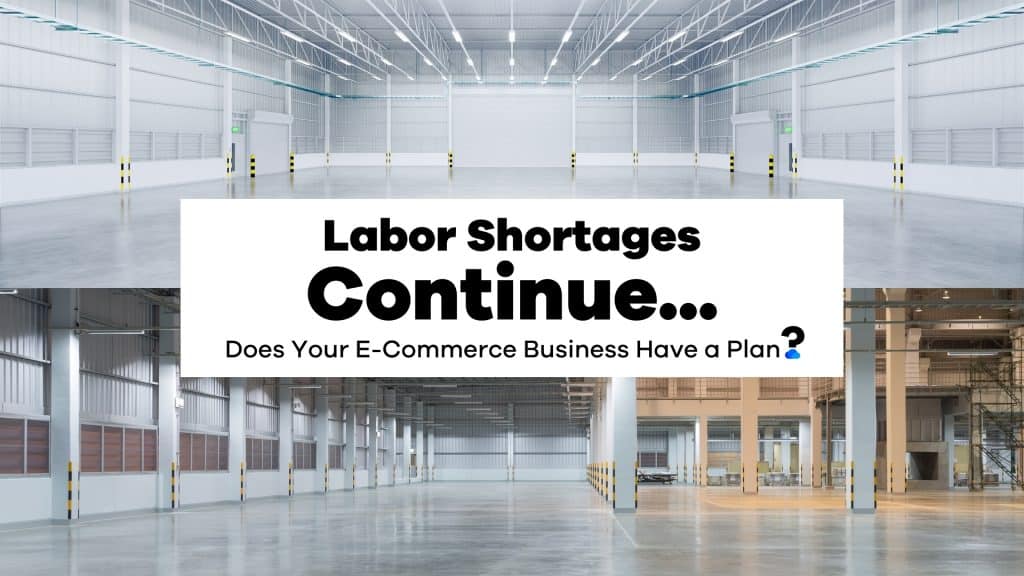
As of January 2022, there were 11 million open jobs in the United States. At the same time, nationwide unemployment continues approaching some of the lowest rates in decades.
This combination has resulted in labor shortages in some of the most vital ecommerce industries. There are significantly more open jobs than willing workers to fill them.
While analysts point to various causes and effects of the national labor shortage, your ecommerce business must have the strategies and tools to navigate its challenges.
There is no telling how long this worker shortfall will last.
There are Labor Shortages Across Multiple Industries Related to E-commerce
The early stages of the COVID-19 pandemic saw record-setting growth across many e-commerce and e-commerce-adjacent sectors.
Along with this came a surging demand to hire workers in the manufacturing, fulfillment, and retail sectors.
Now, as the economy continues to trend closer to full employment, the potential applicant pools are drying up while e-commerce consumer demand remains higher than it was pre-pandemic.
This has resulted in employee shortfalls that have yet to show any significant sign of resolving.
Identifying the potential costs and delays caused by these labor shortages is the first step in planning how your e-commerce business can respond and help safeguard your bottom line.
Manufacturing Labor Shortages
The industrial sector has been hardest hit by the current labor shortage.
According to the US Chamber of Commerce, “Even if every unemployed person with experience in the durable goods manufacturing industry were employed, the industry would only fill 65% of the vacant jobs.”
Thankfully, there are signs that a domestic bounceback is already underway. However, the recovery will take some time.
Unsurprisingly, lower employment rates in manufacturing typically lead to decreases in output and productivity.
This can lead to several problems for your online retail business. Thankfully, there are ways to manage disruptions.
Problem: Manufacturing and Supply Chain Disruptions Make Acquiring and Maintaining Inventory Levels a Challenge—Particularly from Your Most Critical Suppliers
Solution: Recalculate the inventory quantities you need on hand to meet customer demand and compensate for slower turnaround time from your suppliers.
You will likely need to consider purchasing in larger quantities to ensure you have the inventory you need on hand—even if it means incurring slightly higher carrying costs.
To make this easier, Sellercloud allows you to set and adjust your predictive purchasing thresholds. This allows you to replenish your stock levels with enough lead time to avoid backorders and out-of-stocks.
Problem: Increasing Inventory and Stock Costs Create Smaller Profit Margins
Solution: Actively reprice your products across the channels where you sell to maintain acceptable margins while also remaining competitive.
Inflation is driving up costs across nearly every sector. It is well within your right to pass on added expenses to consumers. It is also likely your competitors probably already are.
Sellercloud allows you to manage prices across your entire omnichannel reach from a single, convenient interface.
Furthermore, our integrations with leading repricers can help you automate this process and boost your competitiveness across some of the most popular third-party marketplaces.
Retail and Warehousing Labor Shortages
Much has been made of both the hiring and employee churn challenges facing the retail industry.
The fight to acquire and retain the workforce necessary to keep warehouses running, fulfillment flowing, and e-commerce businesses growing is real.
Everyone from industry leaders like Amazon and Walmart to smaller mom-and-pop operations is pressured to keep essential positions filled.
These labor-related issues will likely cause problems for most e-commerce companies struggling to endure the current hiring challenges.
Problem: Finding and Hiring Workers Has Become Prohibitively Challenging and Expensive
Solution: Rethink your hiring pipelines. It is very likely that if you haven’t already felt the labor crunch within your own business, you will.
With such a competitive labor market, finding the perfect hires can become costly and time-consuming. You will likely need to be more aggressive in your scouting and hiring practices than you have been before.
There are some considerations for both the short- and long-term hiring practices that could help you weather the storm:
- Offer perks like higher wages, bonuses, and/or fringe benefits.
- Explore automation and AI-driven support options.
- Work with staffing agencies and hiring websites.
- Pursue untapped potential through outreach to technical schools, local organizations, and veterans’ groups.
No matter the method(s) you choose, it is in your best interest to keep the door open for prospective new hires.
You never know when you might need to scale your team or replace a key member, so it’s always best to have resumes and potential candidates ready when possible.
Problem: High Rates of Employee Retirement, Burnout, and Turnover Are Making It More Challenging than Ever to Keep Your Existing Workforce
Solution: Prioritize improving employee retention. Now more than ever, you want to protect your staff and reduce unnecessary churn and turnover.
Beyond the basics, such as providing competitive wages and showing appreciation and respect, today’s employees are looking for the potential for upward mobility.
By creating a workplace environment where promotions from within are common, you remove some of the appeal of losing team members to greener pastures elsewhere.
Moreover, once you factor in the costs of lost productivity, hiring, and onboarding, it is almost always more efficient to promote and/or retrain an existing employee than hiring a new one.
Today’s workers are also very much aware of the benefits of a work/life balance. Offering more flexible and responsive scheduling options can be a strong way to show your staff that you value them as people, not just as cogs in the machine.
Should you lose staff, be wary of how you spread the responsibilities amongst those who remain.
The concept of a ‘loyalty punishment’—additional work and responsibilities piled on employees who choose to stay—can quickly cost you some of your best workers.
This is particularly true in a job market skewed heavily in employees’ favor.
Shipping Labor Shortages
Even if your inventory and internal teams run smoothly, the freight and shipping industries remain understaffed and overworked, which is one of the biggest logjams in the retail economy.
An ongoing shipping container crisis, a nationwide trucker shortage, congestion at the ports, and fulfillment companies stretched paper thin have created a perfect storm that continues to make moving stock and merchandise a challenge.
Like the manufacturing crunch, there is little you can do to remedy the larger issues at play here.
If your e-commerce brand does not have a first-party system for moving goods and completing last-mile deliveries, you are relying on these types of services to do business.
Problem: Shorthanded Shipping and Freight Companies Lead To Delays That Prevent Your Customers from Getting the Products They Expect When They Expect Them
Solution: You need to be as transparent and forthright with your customers as possible so that your shipping realities match their expectations.
Both your listings and your contact with customers should provide specifics about any potential for fulfillment delays.
This can prevent customer service headaches later on and help establish your brand as honest and responsible.
If these delays become more frequent, it may be a sign that you need to explore a broader range of shipping and fulfillment options.
Sellercloud integrates with many leading domestic and international shipping partners and a host of third-party logistics (3PL) providers, which can help you move products reliably.
Adding these partners into your existing workflows is simple with Sellercloud’s API- and EDI-powered support.

Mitigate the Harm to Your Business From Labor-Related Disruptions
There is likely real uncertainty surrounding how the labor market and resulting inflationary pressures will impact your e-commerce business in the short and long term.
Many of these issues exist outside your company’s control; the best you can do is try to take the initiative to offset the risks and potential disruptions.
That said, in addition to the solutions outlined above, there are additional proactive steps you can take to reduce the extent to which your business’s employment challenges affect your productivity and profitability.
Be Flexible in Your Third-Party Partnerships
Whether finding alternative suppliers or exploring new shipping and fulfillment partners, the third-party vendors you have relied on may not always be the best option in uncertain times like these.
Putting your eggs into a few baskets—especially when labor shortages continue to impact productivity—can quickly become a costly risk.
It is essential to regularly assess your critical vendors and suppliers. When you identify troublesome or unreliable service, it’s time to pivot.
It is a huge advantage to have a unified, omnichannel e-commerce platform like Sellercloud.
Our over 350 integrations with industry-leading e-commerce partners allow you to find the outside support you need and seamlessly integrate new partners into your existing workflows.
Use Technology to Boost Productivity, Increase Profits, and Improve the Work Experience for Your Team
In the current hiring market, you want to eke out every ounce of profit and productivity from the team you already have.
One of the best investments you can make is in an omnichannel growth platform and supporting warehouse management tools that empower your entire staff to make the most of their efforts.
Sellercloud makes it possible to do more with less by combining familiar technology and intuitive, interconnected e-commerce systems at your workers’ fingertips.
The results are smoother onboarding, shorter training times, increased marketplace agility, and better-optimized fulfillment than your competition can offer.
Contact us for a free demo and see the value Sellercloud can add to your team and how it can help support that team as it scales.




